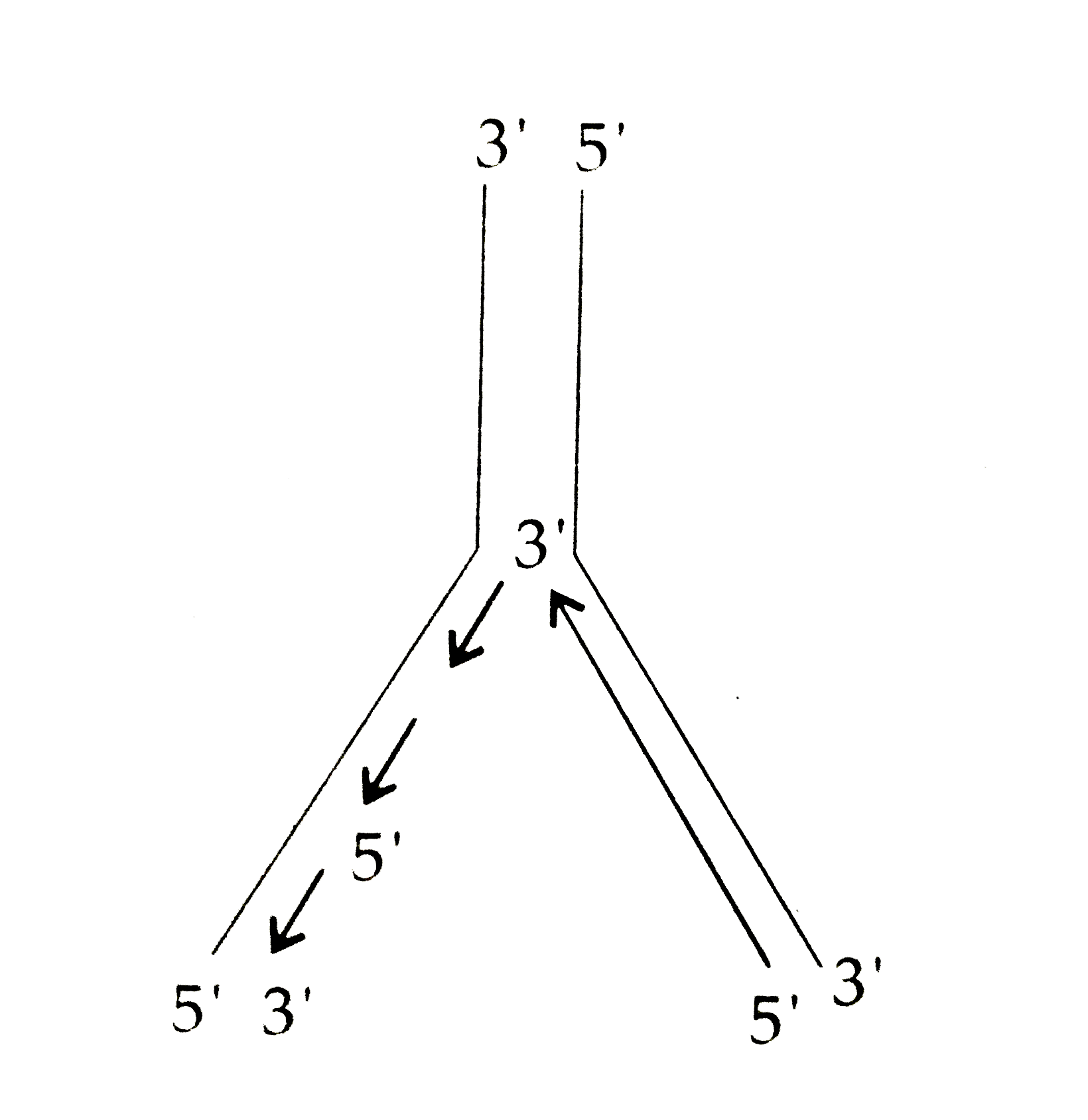Why do you see two different types of replicating strands in the given DNA replication fork? Explain . Name these starands.
Step-by-Step Solution:
1. Understanding DNA Replication Fork:
- The DNA replication fork is the area where the double-stranded DNA is separated into two single strands, allowing for replication to occur. This fork resembles a Y-shape.
2. Direction of Replication:
- DNA replication occurs in a specific direction, from the 5' (five-prime) end to the 3' (three-prime) end. This is crucial as it dictates how the new strands are synthesized.
3. Identifying the Strands:
- In a replication fork, there are two types of strands:
- Leading Strand: This strand is synthesized continuously in the same direction as the replication fork is opening. It runs from 5' to 3'.
- Lagging Strand: This strand is synthesized discontinuously in the opposite direction of the replication fork. It runs from 3' to 5' and is formed in short segments known as Okazaki fragments.
4. Role of Enzymes:
- The enzyme helicase unwinds the DNA double helix by breaking the hydrogen bonds between the base pairs.
- Primase synthesizes a short RNA primer that is necessary for DNA polymerase to begin adding nucleotides.
- DNA polymerase adds nucleotides to the growing strand, synthesizing new DNA.
- The Okazaki fragments on the lagging strand are later joined together by the enzyme DNA ligase.
5. Conclusion:
- The presence of two different types of strands in the DNA replication fork is due to the antiparallel nature of DNA and the directionality of DNA synthesis. The leading strand is synthesized continuously, while the lagging strand is synthesized in fragments.
Naming the Strands:
- Leading Strand: The strand that is synthesized continuously in the direction of the replication fork.
- Lagging Strand: The strand that is synthesized discontinuously in fragments (Okazaki fragments) away from the direction of the replication fork.
---
- The DNA replication fork is the area where the double-stranded DNA is separated into two single strands, allowing for replication to occur. This fork resembles a Y-shape.
- DNA replication occurs in a specific direction, from the 5' (five-prime) end to the 3' (three-prime) end. This is crucial as it dictates how the new strands are synthesized.
- In a replication fork, there are two types of strands:
- Leading Strand: This strand is synthesized continuously in the same direction as the replication fork is opening. It runs from 5' to 3'.
- Lagging Strand: This strand is synthesized discontinuously in the opposite direction of the replication fork. It runs from 3' to 5' and is formed in short segments known as Okazaki fragments.
- The enzyme helicase unwinds the DNA double helix by breaking the hydrogen bonds between the base pairs.
- Primase synthesizes a short RNA primer that is necessary for DNA polymerase to begin adding nucleotides.
- DNA polymerase adds nucleotides to the growing strand, synthesizing new DNA.
- The Okazaki fragments on the lagging strand are later joined together by the enzyme DNA ligase.
- The presence of two different types of strands in the DNA replication fork is due to the antiparallel nature of DNA and the directionality of DNA synthesis. The leading strand is synthesized continuously, while the lagging strand is synthesized in fragments.
- Leading Strand: The strand that is synthesized continuously in the direction of the replication fork.
- Lagging Strand: The strand that is synthesized discontinuously in fragments (Okazaki fragments) away from the direction of the replication fork.
Similar Questions

Why do you see two different types of replicating strands in the given DNA replication fork ? Explain. Name these strands.
View SolutionExplain the process of DNA replication.
View SolutionWhat do you understand by "origin of replication" ?
View SolutionName five different types of motion you know.
View Solution
AB and CD represent two strands of a DNA molecule. When it undergoes replication, forming a replication fork between A and C:
Name the template strand for replication.
View SolutionDuring replication of DNA, the number of template strands is
View SolutionEukaryotes differ from prokaryotes in the mechanism of DNA replication due to
View SolutionWhy do sounds differ? Explain with example.
View SolutionMention different types of RNA. How does RNA differ from DNA? Explain.
View SolutionA 3' ______________ 5' B
C 5' _______________ 3'D
AB and CD represent two strands of a DNA molecule. When this molecule undergoes replication, forming a replication fork between A and C in the above.
(i) Name the template strands for replication.
(ii) Using which strand as the template, will there be continuous synthesis of a complementary DNA strand?
(iii) Complementary to which strand will Okazaki segments get synthesised and discontinuous synthesis will occur
(iv) What are template strands and Okazaki pieces?
(v) In which direction is a new strand synthesized?
View Solution
